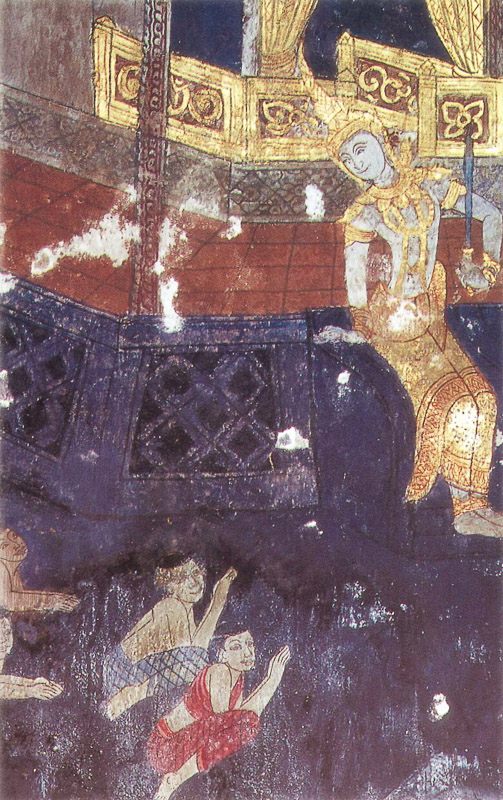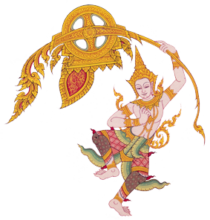
The Bodhisatta was once a king. A wealthy merchant’s daughter was as beautiful as a heavenly nymph, and any man who saw her could not contain himself. Her divine beauty was not a random stroke of luck. In a previous life she was a poor girl who wanted a scarlet robe like beautiful noblewomen wore, so she went to work for a wealthy family to earn one. She served them well, and one day the family gave her the gorgeous robe she desired. She went down to the river to bathe before trying it on. While there, a holy man walked by, covering himself with just a tree branch because his clothes had been stolen. Wanting to help him, she tore her new robe and gave him half. And he looked so splendid in it that she gave him the other half too. She then prayed that in some future birth she would be the loveliest woman in all the land, and everyone who saw her would be unable to control themselves.
When the merchant informed the Bodhisatta about his lovely daughter, he sent fortune-tellers to read her lines. But the moment they saw her face they lost their self-control and did things like putting food on their heads instead of in their mouths. The daughter, disgusted by their behavior, had them thrown out of the house by the scruff of their necks. Outraged over this, the fortune-tellers told the Bodhisatta she was a witch and not a suitable wife for him. Upon hearing that the king had rejected her, she bore a grudge and vowed to get back at him someday. Later, the merchant gave his daughter to the commander-in-chief, a childhood friend of the Bodhisatta, for marriage.
One day during a large festival, the Bodhisatta made a circuit of the city in full pageantry. The commander-in-chief told his wife that the king would pass their house, and she must not show herself so he would not lose control of his thoughts. But this was her chance at revenge, and when the Bodhisatta arrived, she went to an open window and threw flowers over him from above. He looked up and saw her and became maddened with passion. The Bodhisatta asked his charioteer whether she was married or not, and when he told the Bodhisatta who she was, he canceled the rest of the procession. He returned to the palace, obsessed and depressed, muttering to himself about this woman. The commander-in-chief scolded his wife for disobeying him and set out to save the Bodhisatta, knowing such passion could kill him.
The commander-in-chief made a clever plan with one of his servants and sent him to hide in a hollow tree that was a sacred shrine. The next day, the commander-in-chief, publicly for all to hear, asked the tree’s “spirit” what was ailing the Bodhisatta and how to save him. His servant answered, as the commander-in-chief had ordered him to, that “Your king is not sick, rather he is infatuated with your wife. If you want him to live, you must let him have her.”
The commander-in-chief set off for the palace and met with the Bodhisatta, reporting what the spirit had just told him to do. He insisted the Bodhisatta take his wife for as long as needed to satisfy his urges, promising not to tell anyone else about their arrangement. The Bodhisatta felt great shame that the gods knew about his behavior. He thanked his friend for his kindness, but said no matter what he might gain, he was a righteous man and would never do something that would cause another person to suffer. The two discussed the matter further, and after hearing his commander-in-chief preach that heaven was the reward for a righteous path, his infatuation vanished.
In the Lifetime of the Buddha
One of the Buddha’s disciples, while out on a morning alms round, saw a woman so beautiful he fell in love at first sight. The lovesick disciple became lean as a wild deer and could no longer concentrate on his studies or meditation. The Buddha told him this story so he knew that lust had risen in his own heart in the past, but the condition vanished before he did anything improper, so the disciple should persevere.
The commander-in-chief, charioteer, and wife were earlier births of Sariputta, Ananda, and Uppalavanna, three of the Buddha’s top disciples, and the king’s courtiers were earlier births of the rest of the Buddha’s disciples.
